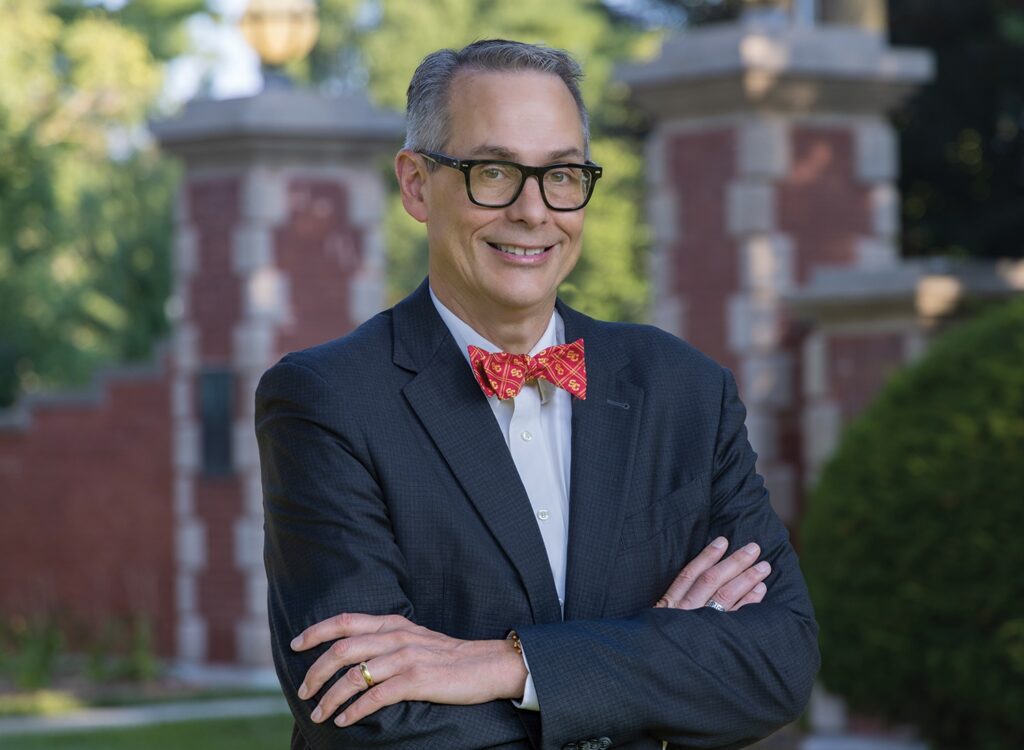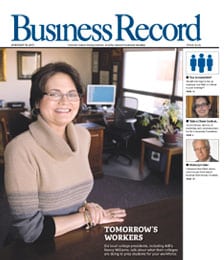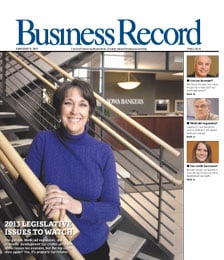Finding their calling

For high school seniors, crunch time is near as they find themselves asking: “Where will I go to college? What will I do when I get there? And how will I pay for it?”
More students are taking the post-secondary education route out of high school, even though college costs have skyrocketed. And for those students who spend an extra year or two taking classes to try to find their calling in life, the price tag only gets larger.
But Gary McClanahan, director of the Des Moines Independent Community School District’s Central Campus, sees answers in that school’s Career and Technical Institute. Rather than being a final stop for high school students who aren’t bright enough to pursue a post-secondary education, or simply not interested, he believes the program serves as a route for teens to explore career options, allows students to simultaneously earn high school and college credits and gives some kids a reason to come back to school day after day.
“Where education should be, I think we’re ahead of the game,” McClanahan said. “That’s not to say there isn’t more we can do. But I think we’re pretty inventive in terms of trying to look at all we can do.”
Though the programs at the institute, as well as those planned for the Story County Career Academy-Hunziker Center under construction near Ames, focus heavily on student development and achievement, they create economic development potential for the state by supplying employers with skilled and eager workers.
“What this facility does is first provide a state-of-the-art training center for high school students,” said David Maahs, executive director of the Ames Economic Development Commission, of the Hunziker Center. “It will provide closer connections between the education community and the private sector, and will encourage students to look at these programs and provide a future workforce for employers in the county.
“We think it is a very instrumental component to our county’s economic development success.”
Success through consolidation
Central Campus evolved from the remnants of Des Moines Technical High School and still resides in that school’s building at 1800 Grand Ave., a former car manufacturing plant. The school district maintained Tech High’s technical training programs, which became the Career and Technical Institute, but incorporated the institute into a four-prong approach that includes Central Academy, with Advanced Placement and other academic courses, World Languages and the English Language Learners program.
McClanahan said it would be cost-prohibitive to offer many of these courses at all or even several Des Moines high schools due to limited enrollment or high equipment costs. Central Campus serves 57 schools in 29 districts and currently has 2,150 students enrolled, most of whom spend a half day on campus and the other half at their home school.
The concept is unique to Iowa, but it has attracted nationwide and worldwide attention. Community college leaders from across the country routinely visit the campus to learn how its certification programs have been established within the Career and Technical Institute. Administrators from schools in Japan, Russia, Germany and Turkey have all visited within the past year.
“You would have to go a long way to find anything that’s as rich as what we do in terms of comprehensiveness in those four program areas,” McClanahan said. “It’s an excellent idea, and really what the state is trying to do in rural Iowa” in terms of consolidating programs to avoid duplication, thereby lowering costs.
In 1999, Central Campus partnered with Des Moines Area Community College to create Iowa’s Shared Programming Initiative, which allows students to earn high school and college credits through its courses. To maintain this agreement, Central Campus teachers have the credentials to be considered adjunct DMACC instructors and are required to bring their courses, including those in the Career and Technical Institute, up to the community college level with textbooks and curriculum.
“For years there was a perception that only certain students took vocational education courses because they couldn’t be successful in traditional academics,” said Erin Stoen, coordinator of the institute. “But these are college-level courses. If you open an automotive handbook, you have to be able to read at a 13th-grade level.”
Randy Mead, DMACC’s dean of program development, said these career and technical programs enable students to do preliminary coursework in high school and avoid duplication of courses between the high school and college, thereby saving time and money. At DMACC, about 30 percent of the students who enrolled for the fall 2005 semester already had college credits on their transcripts.
“I think it also better prepares students coming in to know what’s required and give them a good sense of that in high school,” he said.
In considering its program offerings – the institute has 28 – Stoen said Central Campus evaluates the course’s ability to motivate students, whether the class would make students employable and what growth is expected in that field over time. The ability for a program to keep students in Iowa after high school is considered, but not mandated.
Central Campus faculty and staff constantly re-evaluate the school’s course offerings to ensure that, when possible, state and national certification programs are in place. Central Campus students can receive EMT-Basic certification, and the two-year automotive technology program is certified by the National Automotive Technology Education Foundation. Several other certified courses enable students to obtain jobs immediately after high school graduation.
“It sometimes dispels the notion that a four-year degree is the only route to travel,” McClanahan said. “Though I’m an advocate of that with two master’s degrees and a doctorate, I’m also wise enough to see that I spent a lot of money to get those degrees. I see some students coming right out of (the Career and Technical Institute) making $70,000 a year.”
Meeting their needs, too
Some programs that have been in existence for many years have been upgraded to incorporate new technologies, and others, such as Web page design, have been added as the workplace demands those skills. Central Campus works with more than 100 Greater Des Moines businesses to stay up to speed on industry trends and needs, and to keep its faculty members in tune with the real world applications of what they’re teaching. McClanahan said those relationships are critical to the overall success of the programs.
Central Campus discontinued its printing class in the 1990s, a result of waning enrollment, the instructor’s retirement and the high cost of replacing outdated equipment. But Greater Des Moines printers grew concerned that, in the absence of that program, fewer skilled workers would join a local industry that desperately needed them.
The average age of a printing production worker is 55, which creates a looming worker shortage for the third-largest industry in Iowa as those employees near retirement age, said Ron Hoyt, president of Carter Printing Co. and chairman of the Graphics Communication Education Task Force, which was created in response to the problem.
In 2000, the task force partnered with Printing Industries of the Midlands and the school district to create the Central Campus Project. The professional groups were instrumental in putting together a curriculum for a new printing class. They acquired about $250,000 in equipment, much of which was donated or provided on loan, and paid the instructor’s salary for the first three years. Printers have also arranged for job-shadowing sessions and hire students as interns during their senior years. Hoyt said his shop’s workforce is rather static, largely the result of a changing economy since the class was reinstated.
“The economy has changed a little bit and the number of people working (in the industry) has decreased due to some shop closures,” Hoyt said. “Some of the people who would have retired lost their jobs and others who may have retired probably found out that, because of the downturn, it behooved them to work a couple more years.
“What we anticipated hasn’t happened yet, but it’s going to.”
Betts Auto Campus is one of several Greater Des Moines dealerships, faced with similar shortages in their service departments, that have made Central Campus a pipeline for future skilled workers.
In addition to their coursework at Central Campus in Automotive Technology, students are assigned a mentor from one of the participating dealerships. They observe their mentor at work and, when possible, receive hands-on experience. Following high school, Betts sponsors students through a two-year trade school program, during which they can gain on-the-job experience at the dealership, with the intention of becoming full-time employees following the completion of their education.
“We have the satisfaction of taking young people and seeing them develop and become real partners in our business,” said Jim Lebeda, Betts’ service manager. “We’ve held these young people to the same standard and look to them as future employees.”
Several health-care providers have partnered with Central Campus to encourage to students to consider careers in the field. Kevin Elsberry, acting human resources director at Mercy Medical Center, said the hospital’s participation in the program is designed to entice a future generation to enter professions such as nursing that are already in high demand.
In addition to classroom work, students from Central Campus’ various Careers in Health courses spend about two hours every Friday over a five-week period at Mercy and other hospitals job-shadowing health-care professionals in a variety of fields.
“We are relying on students to be future health-care providers, and hopefully this will pique their interest,” said Linda DeVries, Mercy’s staff development and education coordinator. “It’s a win-win for students because they can take the theories they’ve learned and see them being applied.”
Though not necessarily driven by industry demand, the institute’s Aviation Technology program is one of its most popular and has provided students with educational opportunities nearly unmatched not only in Iowa but nationwide. The program was founded in 1943, making it the second oldest aviation technology program in the country, and is one of only four high school programs in the nation that are FAA Part 147 Certified, enabling students to become certified airframe and power plant technicians, according to instructor and department chair Jerry Bradley.
Aviation Technology students work from a 30,000-square-foot laboratory at Des Moines International Airport that houses aircraft such as a Cessna 337 and a U.S. Army AH-1S Cobra helicopter. In addition, seniors who meet certain academic requirements can spend 15 weeks with Iowa Air National Guard F-16 fighter jet mechanics.
Saving some dough
The Aviation Technology program has served as an example of what the Career and Technical Institute can provide in terms of student achievement and career guidance. Over three years, students in the three-year program can earn up to 48 credits from DMACC, which can also be transferred to other post-secondary institutions. Since Bradley came on board more than seven years ago, more than 85 percent of students in the program have either pursued post-secondary coursework in aviation or have entered the industry directly out of high school.
The same can be said for other institute programs as well. Since its inception in 2002, all but two students who have gone through the institute’s Teacher Academy have gone on to pursue a teaching career.
“If we train students to be great in academics, but at the same time do what we’re doing here and spawn an interest in the real world, then we’ve done that student a double service,” McClanahan said.
Since 1999, when the Shared Programming Initiative was established, Central Campus students have earned more than 40,000 college credits, saving them a total of about $3.25 million in college tuition, Stoen said. Many students in the district receive their high school diplomas with enough credits from DMACC to be considered college juniors. McClanahan said those dollars saved can enable some students with limited financial resources to pursue a four-year degree.
According to a study released last week by the College Board, tuition and fees at four-year public universities increased by 7.1 percent this year, driving the total annual cost per student up to $5,491. Costs at private four-year colleges increased by 5.9 percent to $21,235.
But success within the institute is not necessarily determined by how many students continue on in the industries they studied at Central Campus. Quite the contrary, McClanahan said.
“Because what they could have done was, take teaching for example, spend four years in school at a cost of who knows what, only to determine that they don’t like teaching,” he said.
A win-win proposition
Unlike Central Campus’ storied history, the Story County Career Academy-Hunziker Center, under its current consortium structure, was formed seven years ago. It, too, was a result of funding cuts and a need to consolidate costly programs that could draw larger enrollments if offered to students from several high schools.
But the Story County Consortium, which functions as a DMACC operation, was also created at the urging of the county’s leading building contractors, specifically Jon Hunziker, for whose family the center is named. Industry leaders pointed to a need for more skilled workers, and determined that the best way to obtain them would be through a partnership with area school districts.
The consortium began with 32 students and has grown to serve about 250 students this school year from across the county’s seven school districts, according to Mead.
But with classes being held at various locations throughout the county, and even some at DMACC’s Ankeny campus, the school districts and supporters within the business community realized the need for a centralized location to better meet the program’s needs.
That set into motion a nearly two-year effort to plan for the construction of the Hunziker Center, now being built near the intersection of Interstate 35 and U.S. Highway 30. The 30,000-square-foot center, expected to open for the fall 2006 semester, will cost about $6.5 million to construct and equip, Mead said. The academy has secured about $1.5 million in funds, including about $1 million from Story County businesses and $400,000 in federal funds.
When the new building is complete, the academy will provide programs that cover fields such as construction trades, information technology, health care, automotive technology, culinary arts and manufacturing technology. The county’s school districts signed 28E intergovernmental agreements with DMACC that outline the minimum number of students each district agrees to provide to the academy over the next 10 years. Maahs of the AEDC said there will be a minimum of 350 students enrolled at the academy, which will also be used in the evenings for DMACC’s traditional post-secondary classes.
Through the planning and development stages, DMACC and the school districts have established close relationships with Story County employers that are committed to the success of this project, similar to the relationships that have existed for years between Central Campus and Greater Des Moines employers. Not only will the academy produce the next generation of skilled workers, but it will also provide continuing education programs and company-specific training to Story County businesses.
Building the future
The Story County academy hopes to add to its list of program offerings as time progresses, but would have to purchase additional land for expansion purposes if there is too much growth.
At Central Campus, Stoen said the faculty and staff will continue to work employers to evaluate their changing needs. She has considered having conversations with business and school district leaders to explore the potential for programs such as cosmetology and engineering. She also hopes to speak with Iowa Workforce Development officials to determine what Iowa needs in terms of programming.
But faculty and staff are also looking ahead to 2009, when the district hopes to move the school’s programs out of its current home. According to a plan approved July 12 by the Des Moines School Board, Central Academy and the World Languages program will relocate to a newly built site, an expansion of the John and Mary Pappajohn Higher Education Collaborative. Edmunds Academy of Fine Arts, located at 1601 Crocker St., would be replaced by a 200,000-square-foot Career and Technical Campus.
McClanahan said he’s hoping for the “wow” effect with people who walk through the doors of those new facilities.
“I want the second wow to be ‘I can’t believe what you’re doing for kids,’” he said. “I want the double wow.”







